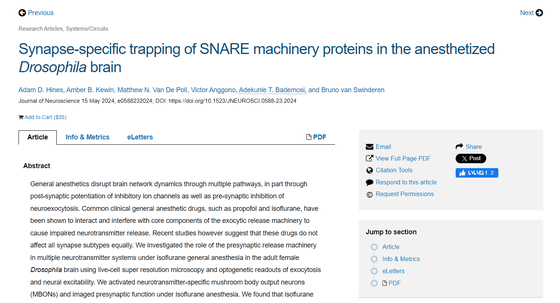The long-standing mystery of 'why general anesthesia works?' shows signs of being solved; the key lies in protein structure

More than 350 million surgeries are performed worldwide each year, some of which use general anesthesia. However, the reason why general anesthesia works has not been fully elucidated. A research team led by Adam D. Hines, a researcher at Queensland University of Technology, has reported that they have discovered part of the mechanism by which general anesthesia selectively shuts down neurons.
Synapse-specific trapping of SNARE machinery proteins in the anesthetized Drosophila brain | Journal of Neuroscience

After 180 years, new clues are revealing just how general anaesthesia works in the brain
https://theconversation.com/after-180-years-new-clues-are-revealing-just-how-general-anaesthesia-works-in-the-brain-229713
General anesthesia has a long history and is said to have been used in various parts of the world, including ancient Sumer and Babylonia. In Western medicine, the world's first surgical procedure using ether anesthesia was performed in 1846. There is also a record that in Japan, Hanaoka Seishu successfully performed the world's first breast cancer surgery using general anesthesia in 1804. However, it has not been clearly elucidated why general anesthesia causes patients to lose consciousness, and it was only in 2020 that it was finally discovered that this may be because anesthetics act on the neurons (nerve cells) of the brain.
'Why do people lose consciousness under general anesthesia?' - a mystery that has remained for over 100 years - is finally being solved - GIGAZINE

There are about 86 billion neurons in the brain, which can be broadly divided into two types: 'excitatory neurons' and 'inhibitory neurons.' Excitatory neurons are responsible for maintaining the brain's wakefulness, while inhibitory neurons are responsible for controlling those excitatory neurons. For example, when inhibitory neurons act on excitatory neurons, 'silencing' them, we fall into a state of sleep.

According to the research team, general anesthesia has the effect of directly suppressing excitatory neurons, speeding up the sleep process. However, the mechanism by which general anesthesia directly suppresses excitatory neurons has not been elucidated until now.
The phenomenon of neurons communicating means that the synapses at the neuron terminals release neurotransmitters such as dopamine, adrenaline, and serotonin. These neurotransmitters are released by the action of specific proteins, and the research team has found that the proteins that act in excitatory and inhibitory neurons are isoforms .
Isoforms are proteins that have the same basic function but differ in some parts of their structure. The research team reported that by observing Drosophila neurons with a super-resolution microscope , they confirmed at the molecular level that general anesthesia selectively inhibits a protein that promotes the release of neurotransmitters in excitatory neurons.

On the other hand, the protein that stimulates the release of neurotransmitters in inhibitory neurons has a different structure from that of excitatory neurons, so it is not inhibited by general anesthesia. The research team says that neurotransmitter release is a complex process that involves many proteins, so it is important to identify which part of which process general anesthetics specifically act on.
Related Posts:
in Science, Posted by log1i_yk







